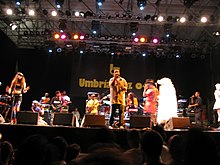ดนตรีกรูฟ

ในทางดนตรี กรูฟ (อังกฤษ: groove) คือการรับรู้ถึงผลกระทบ ("ความรู้สึก") ของการเปลี่ยนแปลงรูปแบบในจังหวะที่ขับเคลื่อนหรือความรู้สึกของ "จังหวะ" (swing) ในดนตรีแจ๊ส สามารถรู้สึกได้ว่าเป็นคุณภาพของหน่วยจังหวะที่ซ้ำกันอย่างต่อเนื่อง สร้างขึ้นจากปฏิสัมพันธ์กันของดนตรีที่เล่นโดยกลุ่มเครื่องประกอบจังหวะของวง (เช่น กลอง เบสไฟฟ้าหรือดับเบิลเบส กีตาร์ และคีย์บอร์ด) กรูฟเป็นคุณลักษณะที่สำคัญของดนตรีป็อป และสามารถพบได้ในหลายประเภท เช่น ซัลซา ร็อก โซล ฟังก์ และฟิวชัน
คำนี้มักใช้กับการแสดงดนตรีที่ทำให้คนอยากขยับตัวหรือเต้นรำและสนุกสนานไปกับ "จังหวะ" (คำนี้ยังมีความหมายทางเพศด้วย)[1] สำนวน in the groove (ใช้ในเพลงแจ๊สมาตรฐานดนตรีด้วย) ใช้กันอย่างแพร่หลายตั้งแต่ประมาณ ค.ศ. 1936 ถึง 1945 ซึ่งเป็นช่วงที่ดนตรีสวิงกำลังได้รับความนิยมสูงสุด เพื่อบรรยายการแสดงดนตรีแจ๊สชั้นยอด ในช่วงคริสต์ทศวรรษ ค.ศ. 1940 และ 1950 คำว่า groove มักจะหมายถึง "กิจวัตร ความชอบ ลีลา [หรือ] แหล่งที่มาของความสุข" ของดนตรี[1]
อ้างอิง
[แก้]- ↑ 1.0 1.1 Kernfeld, Barry. "Groove (i)". The New Grove Dictionary of Jazz, 2nd ed. (Grove Music Online). Oxford Music Online. สืบค้นเมื่อ 16 October 2015.
In the realm of jazz, a persistently repeated pattern. More broadly, Feld (1988), studying groove from an ethnomusicological perspective, defines it cautiously as "an unspecifiable but ordered sense of something that is sustained in a distinctive, regular and attractive way, working to draw the listener in." Connections to dance are important, and the statement that a performance has, or achieves, a groove, usually means that it somehow compels the body to move. Still more generally, the term has a sexual origin and connotation which is obvious, requiring no explanation... Within jazz circles, Gold identifies the phrase "in the groove" – which from around 1936 to 1945 (i.e., during the height of the swing era) was in widespread use in referring to jazz performances which were "excellent" or, by extension, "sophisticated" – and the term "groove" – referring in the 1940s and 1950s to "routine, preference, style, source of pleasure"... Characteristically... [groove] tends to operate with reference to styles from the latter third of the twentieth century which utilize characteristic accompanimental ostinatos drawn from African-derived dance music, whether African-American (e.g., soul, funk, disco, rap, hip-hop), Afro-Cuban dance music (e.g., salsa), or Afro-Brazilian (samba), or some other such fusion.
(ต้องสมัครสมาชิก)
